Related Research Articles

The Limoniinae are a paraphyletic assemblage of genera within the crane flies, Tipulidae, although they can usually be distinguished by the way the wings are held at rest. Limoniines usually hold/fold the wings along the back of the body, whereas other tipulids usually hold them out at right angles. Snow flies such as Chionea scita have no wings at all. Limoniines are also usually smaller than other tipulids, with some exceptions. Limoniinae are a very large assemblage with nearly 10500 described species in 133 genera, and were historically treated as a subfamily, but their classification is in flux; numerous authors recently treated the group at the rank of family, but subsequent phylogenetic analyses revealed that the remaining groups of tipulids render the group paraphyletic. These flies are found in damp places throughout the world, and many species form dense swarms in suitable habitats.

The Chioneinae are a subfamily of limoniid crane flies.
Theodor Emil Schummel was a German entomologist who specialised in Diptera. Schummel was a private tutor in Breslau. He was a member of Schlesische Gesellschaft für vaterländische Cultur a largely scientific society which received royal ratification in 1809 after the draft of its constitution was sent to the government in Königsberg and published many of his shorter scientific papers on insects in the society's journal Übersicht der Arbeiten und Veränderungen der Schlesischen Gesellschaft für Vaterländische Kultur, abbreviated Übers Arb. Ver. Schles. Ges. Vaterl. Kult.
Chilelimnophila is a genus of crane fly in the family Limoniidae. There is only one known species.
Lechria is a genus of crane fly in the family Limoniidae.
Lecteria is a genus of crane fly in the family Limoniidae.

Limnophila is a genus of limoniid crane flies in the family Limoniidae. There are at least 280 described species in Limnophila.
Limnophilella is a genus of crane flies in the family Limoniidae.
Limnophilomyia is a genus of crane flies in the family Limoniidae.
Limnorimarga is a genus of crane flies in the family Limoniidae.

Limonia is a genus of crane flies in the family Limoniidae. There are at least 430 described species in Limonia. It is somewhat of a 'catch-all' genus, where some members should rightly be placed elsewhere.
Lipsothrix is a genus of crane fly in the family Limoniidae.

Tipuloidea is a superfamily of flies containing the living families Cylindrotomidae, Limoniidae, Pediciidae and Tipulidae, and the extinct families Architipulidae and Eolimnobiidae.

The Pediciidae or hairy-eyed craneflies are a family of flies closely related to true crane flies, with about 500 species worldwide.

Liogma is a genus of crane fly in the family Cylindrotomidae.
Limonia yakushimensis is a crane fly in the family Limoniidae. The species occurs in the Palearctic region. L. yakushimensis is known to rear its young in the fruit bodies of the fungus Lactarius volemus.

Limonia nubeculosa, also known as the short-palped cranefly, is a species of crane flies in the family of Limoniidae.

Phylidorea ferruginea is a Palearctic species of craneflies in the family Limoniidae.It is found in a wide range of habitats and micro habitats: in earth rich in humus, in swamps and marshes, in leaf litter and in wet spots in woods.

Austrolimnophila ochracea is a cranefly in the family Limoniidae. It is a Palearctic species with a limited distribution in Europe It is found in a wide range of habitats and micro habitats: in earth rich in humus, in swamps and marshes, in leaf litter and in wet spots in woods.

Eriopterini is a tribe of limoniid crane flies in the family Limoniidae. There are more than 20 genera and 3,800 described species in Eriopterini.
References
- "Catalogue of the Craneflies of the World (Diptera, Tipuloidea: Pediciidae, Limoniidae, Cylindrotomidae, Tipulidae)". Naturalis Biodiversity Center.